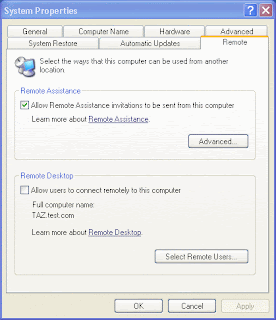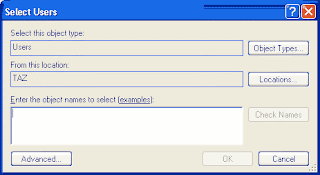There are a lot of options that you can set besides just which computer that you want to connect to. In most cases, you can enter the name (or IP address) of the remote system and just go with the default options. However, there may be times when your needs will dictate fine tuning a session.
To set the various options, Click the Options button. When you do, the Remote Desktop Connection screen will expand to reveal an entire properties sheet, filled with connection options. The General tab lets you select a computer to connect to. You can also use this screen to enter a user name, password, and domain for the connection. If you leave this information blank, Windows will prompt you to enter a password after the connection is established. At the bottom of the General tab, there are options that you can use to save all of your settings. This is helpful if you have a remote machine that has special needs, or if you want to set up a custom configuration to use with all of your remote connections.
The next tab that you’ll see is the Display tab. The Display tab is used to control the way that the remote session appears on the local machine. By default, the remote session will take up your entire screen, although you can use the Display tab to reduce its size. You can also select the number of colors that the remote session will appear in. Finally, at the bottom of the screen, there’s an option to display the connection bar when running in full screen mode. I recommend always using this option. When running in Full Screen, the connection bar will provide you with the name of the computer that you’re connected to and the buttons that you’ll need for reducing the session to a window.
The Local Resources tab is typically one of the tabs that requires the most fine tuning. This tab controls the behavior of the remote session. For example, you can control whether sound is transmitted from the remote computer to the local computer or not. Sound consumes a lot of bandwidth, so you may want to disable it. Likewise, the Local Resources tab allows you to determine when you can use keyboard shortcuts, such as Ctrl, Alt, Delete, to control the remote machine. By default, if the remote session is running in full screen mode, then keyboard shortcuts apply to the remote machine, otherwise, they apply to the local machine.
Finally, the Local Resources tab allows you to control whether you want to control the disk drives, printers, and serial ports on the remote machine. By default, you’ll have control of the remote machine’s printers, but not the disk drives or serial ports.
The Programs tab allows you to specify a program that is to run upon connection to the remote machine. For example, you might run System Information upon connecting.
The last tab that you’ll have to deal with is the Experience tab. The basic idea behind this tab is that it allows you to select what amount of bandwidth that you’ll have available during the remote session. By default, Windows assumes that you’ll be connecting via a 56 Kbps modem. Beneath the connection speed option, there are several check boxes that turn various features on or off. For example, during a low speed connection, you probably don’t want to waste bandwidth by displaying the remote machine’s wallpaper.
As you select your connection speed, Windows enables and disables the various options depending on how much bandwidth that you have available. Fortunately, you can override Windows selections and manually enable or disable any setting that you want. For example, I used to know a guy that created a custom wallpaper for each workstation. The wallpaper was an image that told the machine’s basic configuration information. The idea was that anyone who went to work on the machine would have the machine’s vital stats available to them at a glance. If someone were running a wallpaper like this, they wouldn’t want Windows to disable it during a remote session, and would therefore choose to override the default low bandwidth settings. The options that you can enable or disable are Desktop Background, Show Contents of Window While Dragging, Menu and Window Animation, Themes, and Bitmap Caching.
Connecting To A Remote Machine
What actually happens when you connect to the remote machine depends greatly on how you’ve setup the session. If you simply go with the default settings, your remote session will begin by displaying the usual login prompt. Once you’ve entered a password, Windows will lock the remote machine. When this happens, the remote machine will display the same message that the user would see had they pressed CTRL, ALT, Delete and used the Lock Computer option. If the remote user were to press CTRL, ALT Delete and enter a password to unlock their machine, Windows would drop the remote connection.
As for the local user, the remote session behaves exactly as if the local user were sitting at the remote PC (although possibly slower if bandwidth is an issue). The only thing that the local user has to remind them that they are using a remote session is a small bar at the top of the screen that displays the name of the remote PC. This bar also contains the standard minimize, maximize, and close window buttons. These buttons are handy for situations in which the local user needs to access their own machine for a moment. The close window icon can is used to end the remote session, although you can also end the session by reducing the session to a window and then right clicking on the remote session and clicking selecting the Close command from the resulting properties sheet.
Another interesting thing about running a remote session is the way that screen resolution is handled. In my lab, I connected to a machine that was running multiple monitors. Each monitor was running at a much higher resolution than my test machine. When I connected, Windows set up the local machine as if all of the remote machines were running on a single monitor. It also scaled all of the open windows so that they would fit the local machine’s limited display capabilities.
As you can see, Windows XP’s Remote Desktop feature is an extremely valuable helpdesk tool. This is especially true in organizations in which users are geographically dispersed.

